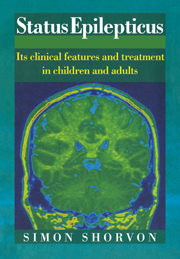Book contents
- Frontmatter
- Contents
- Preface
- 1 The concept of status epilepticus and its history
- 2 Definition, classification and frequency of status epilepticus
- 3 Clinical forms of status epilepticus
- 4 Neurophysiology, neuropathology and neurochemistry of status epilepticus
- 5 Emergency treatment of status epilepticus
- 6 Prognosis and outcome of status epilepticus
- References
- Index
3 - Clinical forms of status epilepticus
Published online by Cambridge University Press: 15 September 2009
- Frontmatter
- Contents
- Preface
- 1 The concept of status epilepticus and its history
- 2 Definition, classification and frequency of status epilepticus
- 3 Clinical forms of status epilepticus
- 4 Neurophysiology, neuropathology and neurochemistry of status epilepticus
- 5 Emergency treatment of status epilepticus
- 6 Prognosis and outcome of status epilepticus
- References
- Index
Summary
As is evident from chapter 2, the classification of status is fraught with difficulties. Objections to a simple seizure-type classification were elaborated upon, and a provisional hybrid scheme was proposed based upon a wider range of clinical criteria. As the level of cerebral maturity and development is perhaps the single most important determinant of the clinical form of status, the primary subdivision of this classification scheme is by age. In this chapter, the clinical forms of status are described and categorised according to this scheme, dealing successively with status in the neonatal period, early childhood, late childhood and adult life.
Status epilepticus confined to the neonatal period
Neonatal status epilepticus
The neonatal brain is immature, myelination is limited, cellular migration unfinished and synaptic connections incomplete. It is consequently not surprising to learn that the appearance of ‘status epilepticus’ differs greatly from those in later childhood or adult life, both from the clinical and electrophysiological points of view, and that the aetiological and anatomico-pathological bases are also distinct. Kellaway & Hrachovy (1983) made an important contribution to the 1980 International Conference on Status Epilepticus. It is noteworthy, however, that their text was devoted largely to seizures rather than status, reflecting the lack of distinction possible in the immature brain, where seizure activity is inchoate and disordered and where the physiological processes underlying both the evolution and cessation of seizure activity are not well formed.
- Type
- Chapter
- Information
- Status EpilepticusIts Clinical Features and Treatment in Children and Adults, pp. 34 - 138Publisher: Cambridge University PressPrint publication year: 1994
- 4
- Cited by



